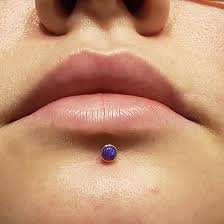Medusa Piercing A Comprehensive Guide to the Philtrum Piercing

The medusa piercing, also known as the philtrum piercing, is a popular facial piercing that has gained significant attention in recent years. Positioned centrally above the upper lip, just beneath the nose, this piercing accentuates the natural contours of the face, offering a bold and stylish statement. Its location makes it a distinctive choice among lip piercings, providing a unique aesthetic appeal.
Understanding the Anatomy of the Medusa Piercing
The medusa piercing is placed in the philtrum, the vertical groove located between the base of the nose and the top of the upper lip. This area is rich in nerve endings, which can influence the sensation and healing process associated with the piercing. The choice of placement is crucial, as it affects both the visual outcome and the comfort level during the healing period.
The Piercing Procedure

Undergoing a medusa piercing involves several key steps to ensure safety and precision. Initially, the piercing professional will assess the anatomy of the area to determine the optimal placement. After marking the spot, the area is cleaned and sterilized to prevent infection. A hollow needle is then used to create the hole, and a labret stud is inserted as the initial jewelry. This process typically takes only a few minutes but requires the expertise of a skilled piercer to minimize discomfort and complications.
Pain and Healing Expectations
The pain associated with a medusa piercing varies among individuals, with many describing it as a sharp sensation that subsides quickly. Due to the concentration of nerve endings in the philtrum area, some may experience heightened sensitivity. Healing times can range from 6 to 12 weeks, depending on individual health factors and adherence to aftercare instructions. During this period, it’s common to experience swelling, tenderness, and minor bleeding, which are part of the body’s natural response to the piercing.
Aftercare Guidelines for the Medusa Piercing
Proper aftercare is essential for the successful healing of a medusa piercing. Recommended practices include:
- Cleaning: Use a saline solution or an alcohol-free mouthwash to rinse the piercing site twice daily. Avoid using harsh chemicals like hydrogen peroxide, as they can irritate the tissue.
- Oral Hygiene: Maintain excellent oral hygiene by brushing teeth gently and using a new toothbrush to prevent bacteria buildup around the piercing.
- Avoiding Irritants: Refrain from touching the piercing with unwashed hands, and avoid oral activities such as kissing or oral sex during the initial healing phase.
- Dietary Considerations: Consume soft foods and avoid spicy or acidic items that may irritate the piercing site.
- Monitoring for Complications: Be vigilant for signs of infection, such as increased redness, pus discharge, or persistent pain. If any of these symptoms occur, consult a healthcare professional promptly.
Jewelry Options for the Medusa Piercing

Selecting the right jewelry is crucial for both aesthetic appeal and comfort in a medusa piercing. Initially, a longer labret stud is recommended to accommodate swelling. Once healing is complete, the jewelry can be downsized to a shorter length to reduce the risk of dental or gum issues. Materials such as titanium or niobium are preferred due to their hypoallergenic properties and durability.
Potential Risks and Complications
While the medusa piercing is generally safe when performed by a professional, there are potential risks to consider:
- Infection: Poor aftercare or exposure to bacteria can lead to infections, characterized by redness, swelling, and discharge.
- Dental Issues: Prolonged contact between the jewelry and teeth can cause enamel erosion or gum recession.
- Rejection or Migration: In some cases, the body may push out the jewelry, leading to migration or rejection of the piercing.
- Scarring: Improper healing or irritation can result in scarring around the piercing site.
Also read 180 Days From Today Understanding the Date Calculation
Conclusion
The medusa piercing offers a unique and stylish way to enhance facial features. With proper care and attention, it can heal successfully, providing a lasting addition to one’s personal style. As with any body modification, it’s important to consult with a professional piercer and adhere to aftercare instructions to minimize risks and ensure a positive experience.







